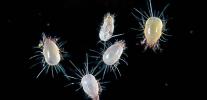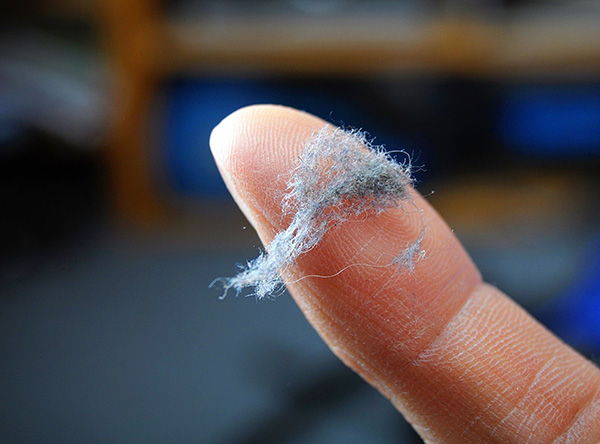
The possibility of developing an allergy to dust mites is practically the only danger to humans from these microscopic creatures. In this case, the allergic reaction is an excessively acute response of the human immune system to contact with certain substances secreted by ticks and contained in the integuments of their bodies.
Pathology can manifest symptoms of varying severity - from a slight nasal congestion or subtle skin irritations to severe asthma and deadly anaphylactic shock.
On a note
According to statistics, it is allergy to house dust mite antigens - the most common cause of asthma in the world. It is also the leading etiological factor in a huge number of cases of chronic rhinitis and other pathologies of the respiratory tract.Often, people do not even suspect that the cause of regular nasal congestion is precisely house dust with dermatophage mites contained in it.
At the same time, dust mites are not human parasites, do not bite him, do not settle on his body and do not spoil food. For people who do not suffer from tick-borne allergies, they do not pose any danger at all.
The photograph taken with an optical microscope below shows the dust mite Dermatophagoides pteronyssinus:
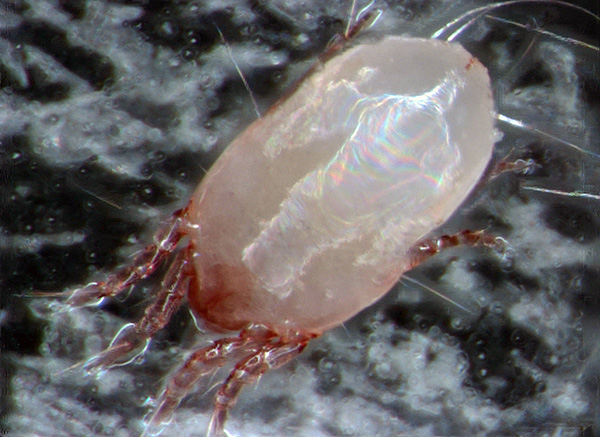
And this is how it looks under an electron microscope:

Nevertheless, the epidemiological significance of dust mites is very high: the number of cases of allergy to them is estimated at millions all over the world, and not a single person is immune from its development, no matter how strong his health (immunity) and no matter how clean his dwelling is . Moreover, as we will see further, cleanliness of the house and strong immunity are factors that are more likely to contribute to the development of allergies than to protect against it ...
The mechanism of development of dust mite allergy
It is known that for many substances that enter the blood or internal tissues of the body and are genetically alien to it, the immune system produces a specific immune response.If in the future this substance enters the body again, the agents of the immune system quickly neutralize it and prevent a possible threat to the body from the substance.
Such substances with a foreign genetic structure that the immune system identifies as supposedly dangerous are called antigens.
The immune system reacts excessively to some of these substances. When an antigen enters the bloodstream or into any tissue, an overly vigorous reaction of the immune response starts immediately, the manifestations of which are often more harmful and dangerous than the antigen itself. And in many cases, the antigen does not pose a threat to the organism at all (for example, waste products of dust mites), although it is identified by the immune system as a dangerous substance.
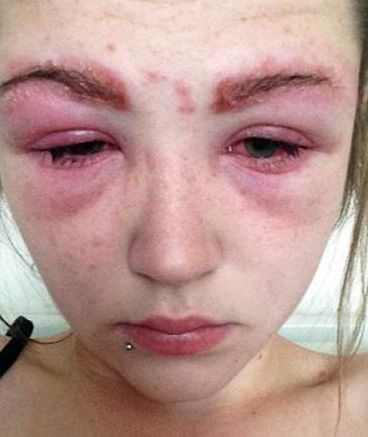
Such an excessive reaction is called allergic, or simply - allergies. The antigens that cause such an excess reaction are called allergens. In fact, based on modern concepts of physiology, allergies can be considered an error of the immune system in distinguishing between dangerous and safe foreign particles.
On a note
Why do such errors occur? It is believed that this is due to excessive "sterility" in which people live. The human immune system, adapted over millions of years to contact and neutralize an enormous amount of antigens, in the conditions of modern civilization is “underloaded.” As a result, it begins to overreact with relatively safe substances.
This hypothesis is confirmed by the fact that the frequency of allergy development is inversely correlated with the standard of living in a particular locality. Simply put, the worse the sanitary conditions in which people live, the lower their probability of developing an allergy to any substance. At the same time, the statistics clearly show that the frequency of allergies in adults who emigrated, for example, from Africa or India to the United States, increases after moving compared with the same frequency as their peers who have remained at home.
Typical allergic rhinitis is a true "adult" disease. Children don’t get sick of them, because their immune systems are already loaded with adaptation to unfamiliar antigens.
The occurrence of an allergy to a particular substance is called body sensitization, and a person with such an allergy is sensitized.Accordingly, if you experience an allergy to dust mites, they talk about tick sensitization. These terms come from the English word "sensibility" - sensitivity, and the allergy itself in scientific circles is often referred to as hypersensitivity.
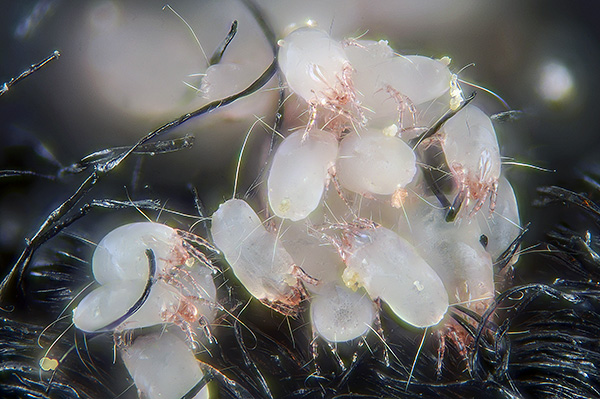
To make the mechanism of development of dust mite allergy even more understandable, the following fact should be taken into account: the more complex the antigen structure and the more biological activity it has, the higher the likelihood that it will cause an allergy. That is why allergies are most often caused by plant pollen, animal hair and down of birds, various berries and fruits - they all contain complex functional proteins with a high molecular weight, to which the immune system is likely to pay attention.
Three types of allergens are associated with dust mites:
- Digestive enzymes contained in the gastrointestinal tract of these arthropods and excreted with excrement. Because of the microscopically small size and insignificant weight, such feces easily rise into the air with dust and are just as easily inhaled by humans, and then cause a hypersensitivity reaction in the upper respiratory tract or in the bronchi;
- Particles of chitinous integuments (cuticle) of mites, which enter the air along with dust during the molting of these creatures, as well as after the death and drying of their bodies;
- Substances contained in the internal organs of ticks that enter the human digestive tract by swallowing live ticks with dust and food.
It is believed that the largest number of cases of allergy to dust mites is associated with two digestive enzymes contained in feces - Der f1 and Der f2. These enzymes are very aggressive towards the cells of the skin and mucous membranes, since they are designed specifically for the digestion of particles of the dermis (skin) - the main food of ticks. For this reason, these allergens can cause allergic dermatitis.
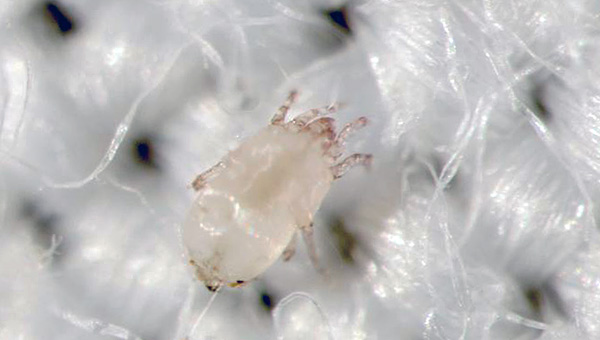
In most cases, allergy to house dust mites is cross-cutting for several species. That is, if sensitization has occurred, for example, to the antigens of the European dust mite Dermatophagoides pteronyssinus, then if you meet with the American Dermatophagoides farinae, the person will also develop an allergy.
Less common is cross-allergy to mite antigens and various synanthropic insects - cockroaches, bedbugs, fleas.In this case, sensitization occurs not on species-specific enzymes, but on certain components of chitinous integuments, which are present in ticks and in other arthropods in the room. Cross-allergy to mites and other components of household dust is less likely to occur.
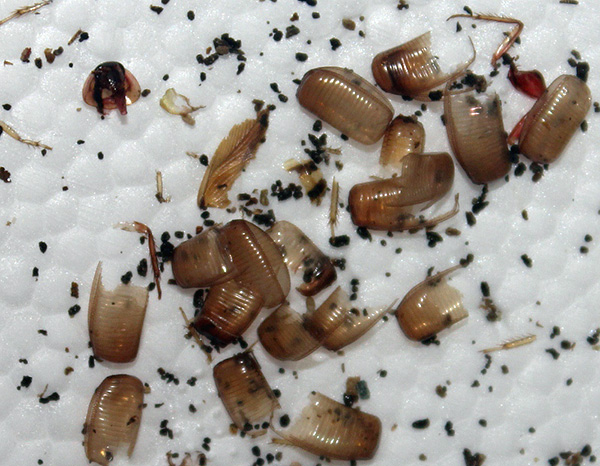
Like any allergy, the reaction to dust mites develops only in some people, and the probability of development and its strength does not depend on the general health of a person or the strength of his immunity. There is even an opinion that the stronger the immune system of a particular person, the greater the likelihood that he may develop allergies (but this hypothesis has not yet been sufficiently confirmed by special studies).
It is interesting
Similarly, there is reason to believe that the cleaner were the premises in which an adult lived most of his life, the higher the risk that this person would experience an allergy when meeting dust mites.
Studies have shown that the development of allergy to dust mites most often occurs when their numbers increase to more than 100 individuals per 1 g of house dust. At the same time, on average, in all the flats examined in the framework of the experiments, the number of ticks exceeded these figures and was 400-500 individuals / g,and in individual apartments it reached 3,500 individuals / g.
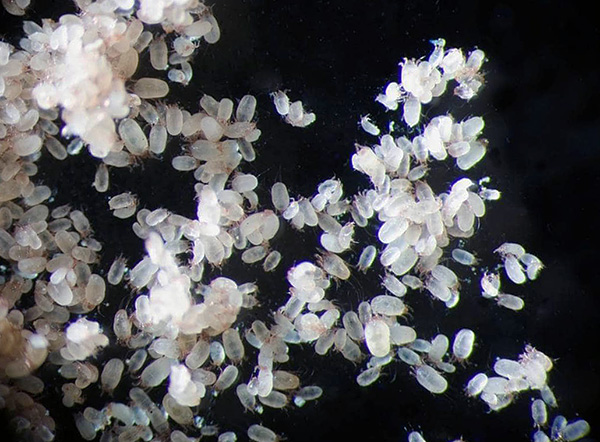
It is important to understand that dust mites and their metabolic products are found in virtually every residential area in the world (as well as outside human housing, if conditions with a suitable microclimate and food are available). This means that most people with some or other frequency meet dust mites, and there is always a risk of developing allergies.
Typical symptoms of an allergic reaction to dermatophagoids
Manifestations of dust mite allergy do not differ much from the symptoms of other allergic diseases, but according to certain signs, the corresponding reaction can be recognized even without a special instrumental diagnosis.
Most often, an allergic reaction to dermatophagoid ticks occurs in the form of one of the following diseases:
- Allergic rhinitis, which develops frequent severe cough, runny nose, nasal congestion, pain in the eyes, sneezing;
- Chronic rhinitis, in which some of the symptoms may be absent. For example, a person manifests only nasal congestion without a runny nose (especially at night), or a runny nose, but without conjunctivitis and cough;
- Rhinoconjunctivitis, in which the leading symptoms are runny nose and nasal congestion, redness of the eyes, tearfulness, pain in the eyes and the appearance of thick discharge from them;
- Atopic dermatitis, developing on different parts of the body in the form of redness, cracking crusts, itching and cracking of the skin.

If a person has tick-borne sensitization, each new episode of allergy usually proceeds harder than the previous one. Not always the difference in severity is noticeable, but over time the patient notes that the symptoms of the reaction became more pronounced, and the general condition worsens much more.
For example, it is in this scenario that asthma develops. Initially, only the mucous membrane of the upper respiratory tract is involved in an allergic reaction. Then the process extends to the middle and lower parts of the respiratory tract, until the edema of the internal surfaces of the bronchi begins.
Similarly, atopic dermatitis may be complicated, for example, by the urticaria.
Anaphylaxis during contact with dust mites is registered only in cases when mites have entered the digestive tract in large numbers.Life-threatening conditions that developed when tick-borne allergens hit the skin or respiratory tract are not described.
An important feature of dust mite allergy is its association with residential premises, most often with a person’s home. This is significantly different from most other allergies: for example, it happens that a person feels at home normally, but begins to sneeze or choke only on the street - when flying poplar fluff or in spring when certain plants bloom. Conversely, in case of tick-borne allergy, symptoms appear or worsen at home, where a person is in contact with dust. In the open air in such cases, the person feels better.

On a note
There are often situations when, in the event of an actual allergy in a child, parents keep him indoors for a long time “with a cold catarrh.” Parents are afraid to let the “simple” child out into the street, so that they “do not blow out” again, wait for the rhinitis to pass, and the rhinitis not only fails, but is aggravated precisely because of constant contact with the allergen.
Definitely make sure that allergies are caused by tick-borne antigens, it is possible only with the help of special studies (see below).
Diagnosis and confirmation of the etiology of the disease in the clinic
Allergies to dust mites need to be differentiated from sensitization to other allergens present in the dwelling: various chemicals, pet dander, house plants, paint, pillow fluff, and much more.
Most often, this problem is solved by conducting skin allergy tests, also known as prick tests. Their principle is simple: if you intentionally introduce a small amount of an allergen into the body, a definite reaction will appear, while substances that are not allergens for a particular organism will not cause such a reaction. However, even if usually the allergy is manifested, for example, by rhinitis, then even subdermal administration of the allergen will cause a clear skin reaction.

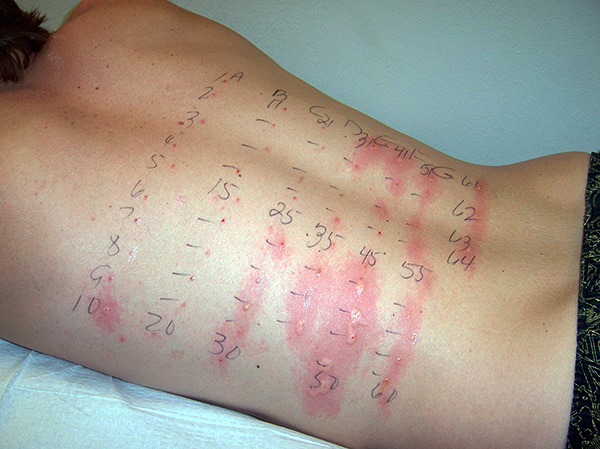
In practice, skin allergy testing is carried out as follows:
- An allergist examines the history and narrows the range of possible allergens. For example, if it is known that the symptoms of allergy are manifested mainly in the house, then the experiment does not include allergens that the patient may encounter only on the street (pollen, for example);
- The area of the skin on the patient’s arm or back is cleaned with ethanol, and drops of histamine, sodium chloride and a set of suspected allergens are applied to it in the form of a mesh.
- A special lancet is applied to the site, which makes light, insensitive punctures of the upper layer of the skin exactly at the locations of the drops. In this case, a liquid with an allergen from every drop penetrates the skin;
- After a certain time (from several minutes to an hour), the doctor evaluates the reaction of the skin. Normally, histamine causes the most violent allergic reaction in any person, sodium chloride does not cause it at all, and at the place of its application, you can evaluate the skin’s response to a puncture. The reaction at the sites of introduction of different allergens is compared with these standards. As a rule, with a standard test, redness with a diameter of 3-4 mm appears at the site of exposure to the allergen, and redness does not develop at all at the injection sites of substances neutral to the body.
The results of such research require professional interpretation. Not always a positive reaction to an allergen is evidence of allergies. Therefore, the doctor should compare the results of the prick test with the data obtained during the collection of anamnesis, the study of the symptoms of the disease, the analysis of reactions to other substances.
The photo below shows an example of the results of such a test:

It is interesting
Diagnostic methods are also known in which patients inhale allergen aerosols. They are held less often, more dangerous, but in some cases more revealing.
In some cases, samples for chitin and other components of the external covers of arthropods can give a positive reaction. In this case, it is not possible to ascertain unequivocally only by the test results which particular “neighbors” in the apartment provoked an allergy. You can get an answer by conducting a survey of the premises: you can simply visually detect bedbugs, cockroaches or other insects that are visible to the naked eye. Here, dust from several places of the room should be investigated with the help of a special test for dust mites - this test allows determining the presence and concentration of mite antigens in dust.

Definitely suspect dust mites in the development of allergies is necessary when such a dust analysis gave a positive result, but no other insects were found in the apartment.
In any case, all the results of such studies should be interpreted only by the doctor, who understands the mechanism and causes of allergy.
Treatment of dust mite allergy: desensitization as the main method of therapy
To date, there is only one method of completely curing allergies to dust mites and several ways to relieve symptoms that provide temporary results.

Complete or sufficient cure provides antigen-specific immunotherapy (ASIT, or more simply - SIT), otherwise called desensitization. Its principle is that an allergen solution is injected under the skin of the patient in the course of several months every 1-2 weeks.
Initially, the concentration of the allergen is very small - it is chosen so that the body practically does not respond to it. With subsequent injections, the concentration is slowly increased, bringing in the last injections to significant amounts. If such a series of injections are carried out correctly, allergy does not occur even once, and the body eventually adapts to large amounts of the allergen and no longer reacts to it under normal conditions.
In practice, full desensitization is not always achieved. In most cases, the procedure is carried out until the body stops responding to the amount of allergen that it encounters in real conditions.This is enough so that a dangerous allergy in a person does not arise anymore, but hypothetically, a situation remains when the patient faces a much larger amount of allergen with the development of an appropriate reaction.
On a note
In some cases, to obtain the desired result, only the initial course of ASIT is performed. If after it the allergy persists, then spend the full course.
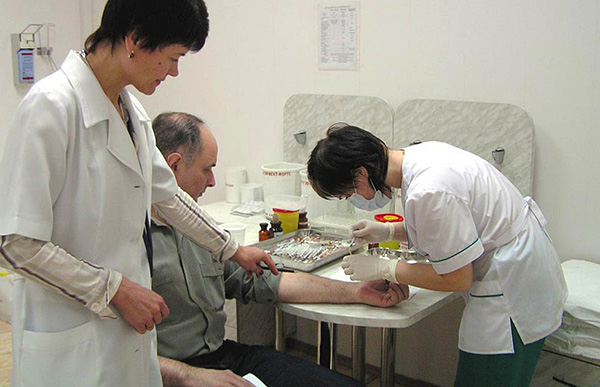
Sometimes ASIT is performed with resorption of the solution in the mouth. However, due to the partial cleavage of the allergen in the digestive tract, it is more difficult to precisely vary the quantities of the substance, and in this form, the procedure is carried out only when the injection to the patient for any reason is contraindicated. Nevertheless, such drugs are gaining popularity due to the possibility of home treatment, and even special preparations for sublingual resorption are produced: Staloral “Allergen of ticks”, Allergovit. Similarly, preparations for injections are commercially available, for example, Alustal “Allergen Ticks”.

With all the advantages of ASIT, it has two drawbacks: the long duration of treatment and the relatively high cost.For this reason, it is not always rational to carry out this procedure: if an allergy develops in a person for a couple of days a year, then it is more rational to use the means of rapid temporary relief of an allergic reaction.
Means for relieving allergy symptoms
Antihistamines are considered the gold standard of allergy treatment. The principle of their action is that the active substance of such a drug blocks receptors that react to histamine and trigger the allergic reaction itself. Even if the allergen enters the body and is recognized by the immune system, at the stage of activation of histamine receptors, the reaction disappears and does not develop further. As a result, the external symptoms of an allergy do not manifest in a person, and if they already exist, they disappear rather quickly.
Antihistamines are available in different forms, but for allergies to dust mites, they are most often used in the form of nasal sprays. It is these sprays allow you to quickly arrest the manifestations of allergic rhinitis. These include, for example, Histimet, Reaktin, Allergodil and others.The main advantage of such intranasal drugs is the absence of systemic side effects in their use.
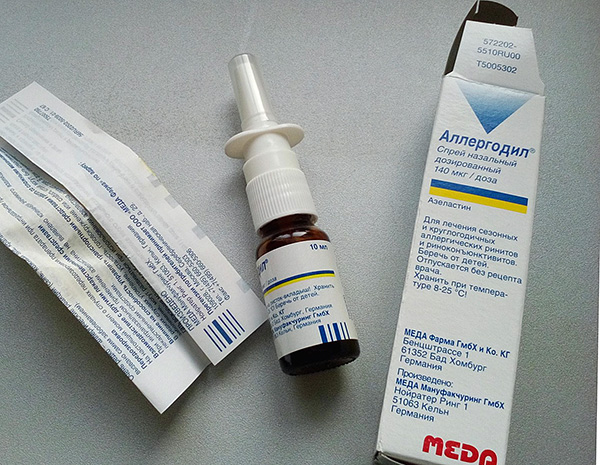
For dermatitis, rhinoconjunctivitis, or urticaria, systemic antihistamines are prescribed in the form of tablets or syrups (for children). The principle of their action is similar to that for sprays, but they are active in all tissues of the body, and not only locally. The most well-known systemic antihistamines include Suprastin, diphenhydramine, Erius, and some others.

Usually antihistamines begin to act 30 minutes after ingestion, and the effect of their use lasts for 12-24 hours.
In allergic rhinitis, the following are also effective:
- Sprays on the basis of corticosteroid hormones - they stop an allergic reaction at the injection sites, while being fairly safe, despite the seemingly dangerous "hormonal" nature. Their active ingredients do not penetrate into the blood and tissues and do not have any systemic effect on the body. Examples of such agents are Nasonex, Alcedin, Fliksonaze and others;
- Nasal decongestants - Naphthyzin, Galazolin, Tezin, relieving the symptoms of an allergic reaction for 3-6 hours and acting very quickly.The effect of the use of the same Naphthyzinum appears already after 2-3 minutes after administration. These drugs are very cheap and available, but chronic allergic rhinitis cannot be treated with them because of the risk of developing tachyphylaxis. It is noteworthy that some drugs contain both decongestants and antihistamine components (for example, Vibrocil).
There are also drugs on the market today that isolate the surface of the nasal mucosa from allergens. These include, for example, Nazaval. However, studies have not shown a significant relief in the condition of patients with allergic rhinitis when using such agents.
If you are allergic to dust mites, nasal washing with 0.9% of sodium chloride solution is definitely useful, since this procedure clears the nasal mucosa from allergens. However, not all people can carry out such washing (many are afraid of him) and, moreover, it does not provide complete relief of unpleasant symptoms.
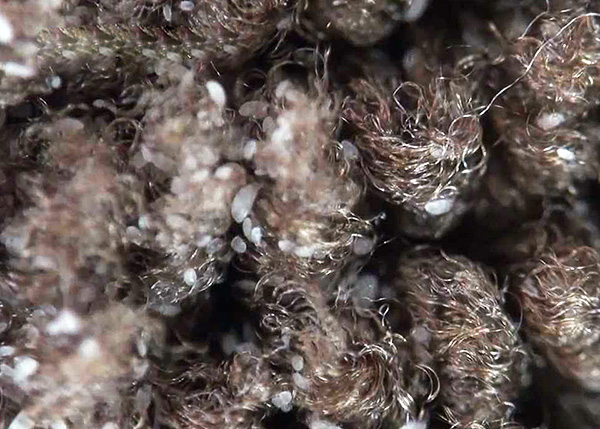
Finally, folk remedies for treating mite allergy are ineffective, and sometimes even completely dangerous for health. Today, not a single natural remedy is known that would completely and quickly stop the symptoms of allergy.At the same time, the majority of folk remedies, which are positioned as anti-allergic, in fact can themselves cause severe allergic reactions.
On a note
A vivid example of pseudo-medicine in this case is camomile pharmacy. Her drugs are unknowingly considered to be hypoallergenic and are often used to treat allergies. At the same time, a significant number of people develop allergies to chamomile, even at least one child’s death from anaphylaxis was described, when parents tried to treat allergic rhinitis in an 8-year-old girl with chamomile.
As a result, if you need to get rid of the symptoms of tick allergy here and now (as quickly as possible, just a couple of minutes), then vasoconstrictor drugs are used. Antihistamines and hormonal sprays are used as a means of more or less “long distance”. For the complete cure of allergy, specific immunotherapy is carried out.
Prevention of tick-borne sensitization
Studies show that with the development of an allergic reaction to dermatophagous mites, simply removing them from the room will no longer provide complete relief from unpleasant symptoms.This is due to the fact that the mites themselves and their antigens are found almost everywhere, and therefore, even feeling normal at home, the sensitized person will feel signs of allergy in other places - at work, at a party, in many other rooms.
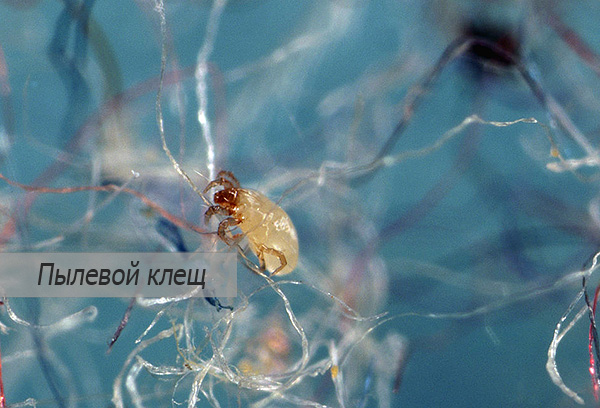
Therefore, tick-borne sensitization is wiser to prevent, instead of being treated for a long time.
What you need to do:
- Remove from your own home the maximum amount of dust. If there are suspicions about the presence of ticks in it, it is useful to check the dust using special test systems, analyze the presence of dermatophages bed, sofa, bedding, pillows and mattresses, if necessary, replace or treat with hot steam those items from which ticks cannot be removed ( the same mattresses). After removal, it is useful to use special agents that destroy antigens that remain in the apartment after removing the ticks themselves. An example of such a drug is Easy Air Allergy Relief Spray;
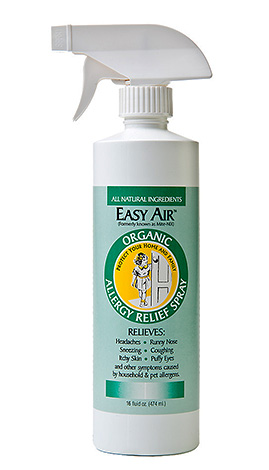
- Regularly hold in the apartment wet cleaning and airing;
- If possible, eliminate unnecessary dust drives - open bookshelves, carpets, and carpets;
- Use bedding with certain parameters: pore diameter not more than 10 microns, tissue tightness for allergens - 99%, dust permeability not more than 4%, air permeability - 2-6 cm3/ (sec * cm2);
- If there are domestic animals living in the room, conduct a study of their wool, and if dust mites are found in it, remove them (ticks of some species often settle in dog hair, less often on cats).
If there are a lot of dust mites in the room, and even careful cleaning does not allow to significantly reduce their number (this happens very rarely), then they destroy arthropods by chemical means - preparations based on pyrethroids, organophosphorus compounds, neonicotinoids. These include, among other things, such common means as Hangman, Get, Xulat Micro, Raptor aerosols, Raid and others.
However, with a responsible approach to cleaning the apartment, the need for such a serious treatment of the room almost never arises.
Useful video about dust mite allergy
This is what dust mites look like inside a pillow.



